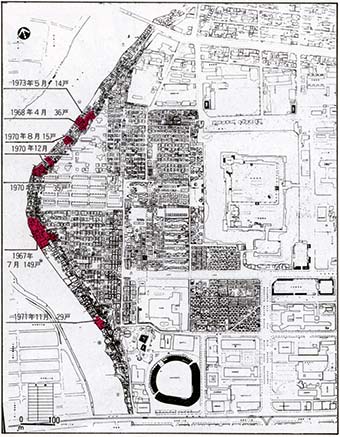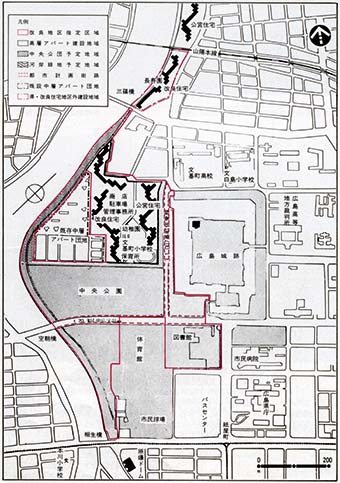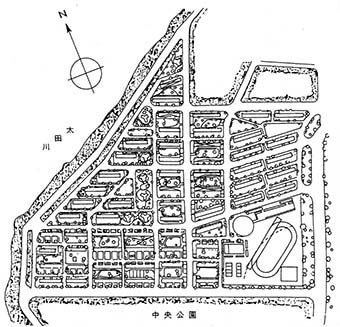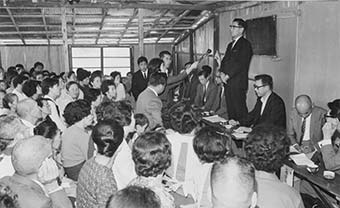From Rebuilding to Redeveloping - 2
Fires
Fires were a frequent occurrence in Moto-machi. With narrow streets and insufficient firefighting equipment, even a small flame could lead to a large disaster.
Fires in Moto-machi

Teitoshiki are raised dirt embankments for flood prevention.
From Commemorating the Moto-machi District Redevelopment Program

Catastrophic fires
A disastrous fire destroyed 149 houses. Since buildings were so close to one another, each time a fire started it quickly spread. In addition, firefighting was in a poor state.
July 27, 1967 Collection of Chugoku Shimbun

Main location of fires along the embankment
This 1966 map of area buildings shows the main location of fires until May 1973.
*From Pictorial History of Forty Years since Atomic Bombing Reconstruction of HIROSHIMA
Towards Redevelopment
The public and private housing constructed in Moto-machi deteriorated over the years. In addition, problems with hygiene and disaster prevention were always present.
Chuo Park had originally been planned for the Moto-machi area, but the city decided to devote some of that land to residential use and replace the dilapidating structures with a medium-rise housing complex. They also made preparations to develop the park land in the way it had been intended.
Construction of the medium-rise housing complex was jointly undertaken by Hiroshima City, Hiroshima Prefecture, and a public housing corporation and 1,894 units were planned. However, even if the old public housing were to be replaced, nothing could be done about the deteriorating illegal housing structures, so it became essential to undertake new redevelopment.
On March 18, 1969 the country designated the western side of Moto-machi for improvements, calling it the Hiroshima Moto-machi District, which took almost 10 years to complete.

Moto-machi District Redevelopment Plan
The area outlined in red was designated for redevelopment.
*From Commemorating the Moto-machi District Redevelopment Program

Moto-machi Medium-Rise Housing Complex Plan
The plan shows the complex facing the south and an area set aside for an elementary school in the south east corner at the bottom right of the map.
*From Commemorating the Moto-machi District Redevelopment Program

Moto-machi residents meet with representatives from the Ministry of Construction
Representatives from the Ministry of Construction, Hiroshima Prefecture, and Hiroshima City inspected Aioi Avenue. About 500 residents from the area gathered and demanded the national, prefectural, and municipal governments adopt a Residential Areas Improvement Act and redevelop the Moto-machi area.
September 28, 1966 Collection of Chugoku Shimbun
The End of Redevelopment
Going beyond the replacement of aging housing, the redevelopment of the Moto-machi district was based on a plan that took into consideration land use throughout the entire area, including the area around Chojuen in neighboring Hakushima.
With the completion of the final high-rise apartment in September 1978, the Moto-machi District Redevelopment Program came to a close. In the Moto-machi area alone 2,964 high-rise units were completed, and with the other buildings that were constructed in the Chojuen area of Hakushima, the total number of new units was brought to 4,566.
Not only was new housing completed, but shopping centers, elementary schools, nursery schools, kindergartens, and other centrally located meeting halls and rooms were built. Furthermore, gardens and walking paths were built on the roofs of the high-rises and they became places to relax and gaze at the cityscape or Seto Inland Sea.

Moto-machi after redevelopment
A block of high-rise apartments has been completed to the east of mid-rise apartments, and Chuo Park is beginning to take shape on the south side.
September 26, 1978 Collection of Chugoku Shimbun
